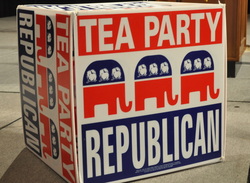THE TEA PARTY: A False Populist Force

I just finished reading Anthony DiMaggio’s second book on the Tea Party phenomenon, “The Rise of the Tea Party: Political and Corporate Media in the Age of Obama” (Monthly Review Press, 2011). The volume comprises 229 pages of bone-dry prose, not including more than 500 detailed footnotes. So it’s not as fun to read as, say, Rolling Stone’s Matt Taibbi. But with dozens of diagrams illustrating a variety of empirical data and observations collected from on-the-ground reporting, DiMaggio does an excellent job of showing how the Tea Party narrative is (as Taibbi says) full of shit.
What distinguishes it from other analyses I’ve seen is not only the avalanche of data, which at times is mind-numbing. It also explores how Republican Party elites manipulate mainstream “journalism” so that the nation’s top networks and newspapers effectively function as a GOP propaganda factory – and then, how that con job manifests itself in public opinion. That’s not just a swipe at FOX. To be sure, Tea Partiers don’t miss a chance to whine about their press, but DiMaggio meticulously shows how – particularly with regard to the insane narrative they concocted about “Obamacare” – they’ve had a free ride on greased rails.
In that respect, “Rise of the Tea Party” is as much an indictment of corporate media as it is of Tea Party politics. Of course, since the Republican Party’s right wing controls a good chunk of the media that Americans rely on for “news,” it may be helpful here to specify individual outlets, since “media” is so inclusive as to be meaningless. Primarily, we’re talking about: NBC, CBS, ABC, FOX, MSNBC, The Washington Post and The New York Times.
DiMaggio persuasively argues that the Tea Party is essentially old wine in new bottles – a deliberate “rebranding” exercise by Republican Party elites. It is not by any standard that may be found in 20th century American history a genuine social movement, it is not grassroots, it is not revolutionary, and it represents no threat whatsoever to the political status quo or financial elites who run the country. Bottom line is, they’re working class and middle class foot soldiers carrying water for the 1 percent, clinging to the Reagan fantasy of “trickle down” economics while taking their cue (if not orders) from guys like Matt Kibbe who laugh all the way to the bank.
The book is packed so tightly with numbers that one wishes there were more anecdotes of the kind that Taibbi and others have excavated, or at least more colorful ones. But that’s not to say DiMaggio didn’t get out the office. He also attended Tea Party rallies and meetings, far more than I would have had the patience for. From his travels and research, he brings back a depressing picture of American political economy and what Henry Giroux calls “the apparatuses of public pedagogy.” I’m not sure if it’s quite right to say I “liked” it, but it’s a valuable investigation. Any journalist who reports on Tea Party politics owes it to their readers or viewers to read it carefully, and then spend some time with those footnotes.
This review originally appeared on my blog on July 29, 2012.
What distinguishes it from other analyses I’ve seen is not only the avalanche of data, which at times is mind-numbing. It also explores how Republican Party elites manipulate mainstream “journalism” so that the nation’s top networks and newspapers effectively function as a GOP propaganda factory – and then, how that con job manifests itself in public opinion. That’s not just a swipe at FOX. To be sure, Tea Partiers don’t miss a chance to whine about their press, but DiMaggio meticulously shows how – particularly with regard to the insane narrative they concocted about “Obamacare” – they’ve had a free ride on greased rails.
In that respect, “Rise of the Tea Party” is as much an indictment of corporate media as it is of Tea Party politics. Of course, since the Republican Party’s right wing controls a good chunk of the media that Americans rely on for “news,” it may be helpful here to specify individual outlets, since “media” is so inclusive as to be meaningless. Primarily, we’re talking about: NBC, CBS, ABC, FOX, MSNBC, The Washington Post and The New York Times.
DiMaggio persuasively argues that the Tea Party is essentially old wine in new bottles – a deliberate “rebranding” exercise by Republican Party elites. It is not by any standard that may be found in 20th century American history a genuine social movement, it is not grassroots, it is not revolutionary, and it represents no threat whatsoever to the political status quo or financial elites who run the country. Bottom line is, they’re working class and middle class foot soldiers carrying water for the 1 percent, clinging to the Reagan fantasy of “trickle down” economics while taking their cue (if not orders) from guys like Matt Kibbe who laugh all the way to the bank.
The book is packed so tightly with numbers that one wishes there were more anecdotes of the kind that Taibbi and others have excavated, or at least more colorful ones. But that’s not to say DiMaggio didn’t get out the office. He also attended Tea Party rallies and meetings, far more than I would have had the patience for. From his travels and research, he brings back a depressing picture of American political economy and what Henry Giroux calls “the apparatuses of public pedagogy.” I’m not sure if it’s quite right to say I “liked” it, but it’s a valuable investigation. Any journalist who reports on Tea Party politics owes it to their readers or viewers to read it carefully, and then spend some time with those footnotes.
This review originally appeared on my blog on July 29, 2012.
